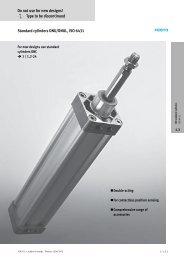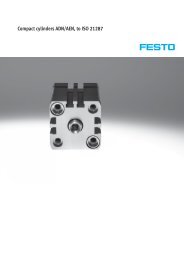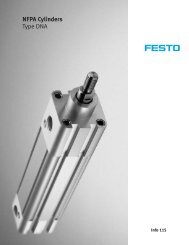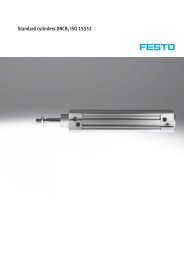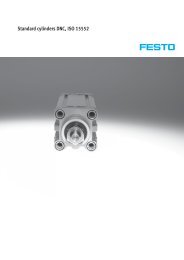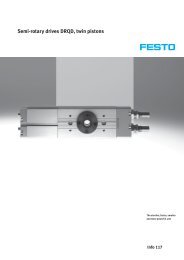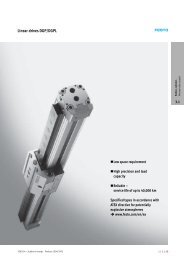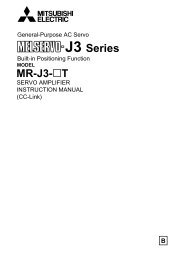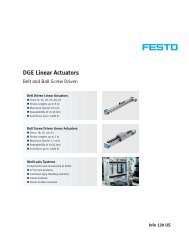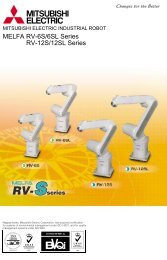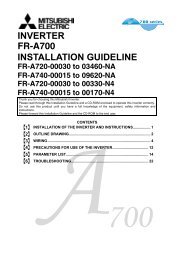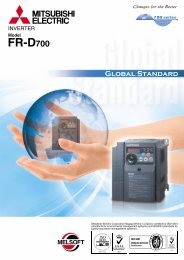RFID Systems - Allied Automation, Inc.
RFID Systems - Allied Automation, Inc.
RFID Systems - Allied Automation, Inc.
You also want an ePaper? Increase the reach of your titles
YUMPU automatically turns print PDFs into web optimized ePapers that Google loves.
Barcode Imaging <strong>Systems</strong>Fundamentals of Barcode Imaginga “grid” over the system. Using this grid, the locationsof black and white modules can be determined. Thisprocedure makes it possible for a reader to evaluatesymbols that are skewed. Perhaps more importantly, byplacing the grid over the symbol the presence or absenceof a black module is determined based on summing up (i.e.,integrating) the amount of black. A sharp transition betweena black module and a white area is not required.• Data RegionThe data region is enclosed by the L-shapefinder patterns and the alternating pattern.It contains not only the data which has beenencoded into the symbol but also includesredundant data according to the Reed Solomonalgorithm to provide the forward error correctioncapabilities of this symbology.• Quiet ZoneFor the software algorithms of the reader toreliably find the symbol it must be surroundedby white space called the quiet-zoneECC 200 symbols have an even number of rows and an evennumber of columns. Most of the symbols are square with sizesfrom 10 x 10 to 144 x 144. Depending upon the application,(to minimize the effect of printing on curved surfaces, or toprint along the narrow edge of a circuit board) symbols canalso be rectangular.Data Matrix symbology occupies approximately 30% ofthe space of a traditional barcode. The only limitation is theresolution of the printing or imaging technique.Omnidirectional ReadingThe fundamental design of the Data Matrix symbologyprovides omnidirectional readability. As discussed earlier,the symbology incorporates a finder pattern that consists oftwo solid bars oriented 90° at the boundaries of the symbol.Across from this at the other edges, is an alternating pattern.With these two considerations, we can print a rectangularsymbol axially along a cylinder (bottle, vials, etc.) and presentmuch less optical deformation of the symbology. This greatlyenhances the readability of the code, especially at highspeeds.Forward Error CorrectionData Matrix codes use a highly developed Reed Solomon errorcorrection algorithm. This process has been successfully usedfor many years. By using mathematical redundancy, whereextra data is incorporated into the symbol, read errors can befirst recognized and then corrected (up to a certain number oferrors). Thus, Data Matrix symbols can be still read even if aportion of the image is obscured or damaged.Sorting or ReadingA barcode imager can offer the capability to read a barcodeand transmit that data or make a go/no go decision internally.In the latter, an internal comparison function examinesthe agreement of a barcode that has been read with aprogrammed reference code; ensuring 100 percent identityin a manufacturing process (e.g., Pharmaceutical). Thoseproducts not matching the reference code can be separatedfrom the mainstream product. In addition, the data that hasbeen read can be transmitted over the interface. An exampleof this control is a sequential serial number in the productionprocess.ApplicationsToday, Data Matrix symbology finds it way into many diverseapplications.Due to its space-saving capabilities, it is possible to replacelegacy 1-D barcodes in an area that is a fraction of theoriginal size, while bringing additional data and integrity to theapplication.On the other hand, completely new applications are nowpossible due to the nature of the symbology. It is possible tolaser etch or peen these symbologies into metal or plasticsurfaces as printing a paper label is no longer a limitation ofthe technology.In this way, the symbology becomes a permanent part of theproduct throughout its lifetime.Barcode BasicsSince the invention of barcodes, this technology has seenconstant change and improvements. Between 1970-80many important standard symbologies were developed andintroduced, most are still used today. These different codesymbologies were developed to address the specific needsof target industries. The following sections on 1-D and 2-Dsymbols list a few reasons for (and against) using one typeover another.Common 1-D Barcode Symbols1-D barcodes are used in every conceivable industry andapplication. The number of existing codes is quite large,allowing users to select the coding mechanism that fits theapplication. However, users must consider those advantagesand disadvantages beforehand. The good news is that most ofthe available 1-D barcode readers are able to read most (if notall) of these codes. We are only going to mention a few codes,list reasons for using them, and possible problems. Commonto all codes is the “Start” and “Stop” symbol. These symbolsallow the reader to determine a unique direction, making itpossible to read from “left-to-right” and “right-to-left.”Pepperl+Fuchs®<strong>Inc</strong>. • 1600 Enterprise Parkway • Twinsburg, Ohio 44087-2245 • www.am.pepperl-fuchs.comTelephone (330) 486-0001 • FAX (330) 405-4710 • E-Mail: sales@us.pepperl-fuchs.com107



